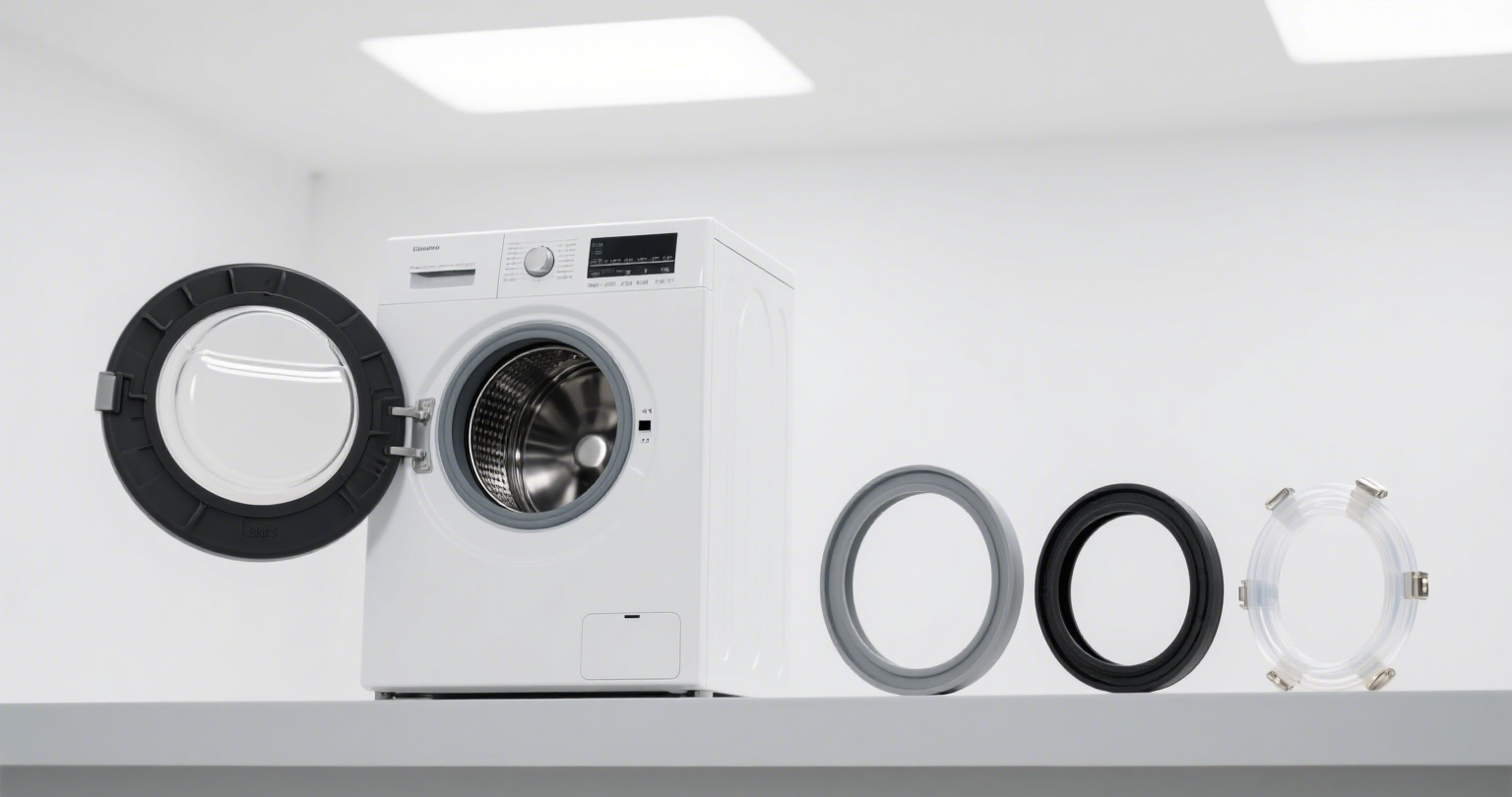Das Verständnis der Rolle von Trommeldichtungen für die Systemeffizienz
Was ist eine Trommeldichtung und warum ist sie wichtig für die Leistung von Trocknerteilen
Die Trommeldichtung spielt eine entscheidende Rolle dabei, Luftlecks an den Stellen zu verhindern, an denen sich drehende Trommeln und feste Bauteile industrieller Trocknungsanlagen treffen. Gute Dichtungen sorgen dafür, dass die gewünschte Hitze erhalten bleibt und gleichzeitig Staub und Schmutz aus unerwünschten Bereichen ferngehalten werden. Funktionstüchtige Dichtungen können den Energieverlust erheblich reduzieren – laut Branchendaten von Parker Hannifin aus dem Jahr 2023 um etwa 25 %. Solche Einsparungen wirken sich spürbar auf den täglichen Betrieb vieler Produktionsstätten aus.
Bedeutung der Leistung von Drehrohrtrockner- und Ofenabdichtungen in industriellen Anwendungen
Drehrohrtrockner- und Ofenabdichtungen sind entscheidend für die Aufrechterhaltung der Prozesskonsistenz in Branchen wie Bergbau, Landwirtschaft und chemischer Verarbeitung. Eine schlechte Abdichtung kann führen zu:
- Wärmeverlusten, die 20 % der gesamten Energiezufuhr überschreiten
- Verunreinigung der verarbeiteten Materialien
- Beschleunigtem Verschleiß benachbarter Komponenten
Daten zeigen, dass 40 % der ungeplanten Stillstände in Drehanlagen auf Dichtungsdefekte zurückzuführen sind, was den Anlagen oft Kosten von über 15.000 US-Dollar pro Stunde an Produktionsausfällen verursacht.
Wie ineffiziente Trocknerteile den Brennstoffverbrauch und die Verarbeitungskapazität beeinflussen
Defekte Trommelabdichtungen am Trockner zwingen die Systeme, stärker zu arbeiten, um die Solltemperaturen aufrechtzuerhalten, wodurch der Brennstoffverbrauch um 15–35 % steigt. Diese Ineffizienz reduziert die Verarbeitungskapazität um bis zu 30 %, da die Anlagen mit Luftstrom und thermischem Gleichgewicht kämpfen. Richtig abgedichtete Systeme erreichen Trocknungszyklen 18 % schneller als solche mit verschlechterten Dichtungen und steigern so die Durchsatzleistung erheblich.
Erkennen, wann eine Trommeldichtung ausgetauscht werden muss
Sichtbarer Verschleiß, Leckagen und Luftverlust als Hauptindikatoren
Wenn Risse entstehen, Spalte mehr als 0,5 mm betragen oder der Verschleiß ungleichmäßig auf den Oberflächen sichtbar ist, beginnt das gesamte System zu versagen. Bei Drehrohrtrocknern führt dieser Schaden insbesondere zu erheblichen Wärmeverlusten. Thermografieforschungen zeigen Effizienzverluste von etwa 15 % an, sobald solche Probleme auftreten. Noch schlimmer ist, dass durch diese Beschädigung Kontaminanten eindringen können, wo sie nichts verloren haben. Undichte Stellen zwischen den Trommelabschnitten sind ein weiterer häufiger Schwachpunkt. Diese Luftlecks verursachen unterschiedliche Trocknungsprobleme innerhalb der Charge. Um diese Unregelmäßigkeiten auszugleichen, erhöhen Anlagenbediener in der Regel den Brennstoffverbrauch, um die Produktionsziele zu erreichen. Diese kurzfristige Lösung verursacht langfristig höhere Kosten, da die Betriebsausgaben kontinuierlich steigen.
Ungewöhnliche Geräusche, Temperaturschwankungen und Anzeichen für Energieineffizienz
Kreischende Geräusche während der Rotation oder unregelmäßige Lagertemperaturen deuten auf falsch ausgerichtete oder versagende Dichtungen hin. Energiemonitoring-Daten zeigen einen Anstieg des Stromverbrauchs um 20–30 %, wenn abgenutzte Dichtungen übermäßigen Reibungswiderstand erzeugen. Diese Probleme treten häufig auf, wenn die Dichtungshärte 80 Shore A überschreitet, wodurch die für eine effektive Abdichtung erforderliche Flexibilität verloren geht.
Geplante Wartungskosten im Vergleich zu Kosten für reaktive Austauschmaßnahmen bewerten
Proaktiver Dichtungsaustausch während geplanter Stillstandszeiten verursacht 40–60 % geringere Kosten als Notreparaturen, bei denen häufig sekundäre Schäden an Lagern oder Heizelementen entstehen. Eine Analyse der Wartungskosten aus dem Jahr 2024 ergab, dass Anlagen, die prädiktive Inspektionsprotokolle einsetzten, dichtungsbedingte Ausfälle um 73 % gegenüber reaktiven Ansätzen reduzieren konnten.
Wichtige Faktoren, die die Lebensdauer von Trommelabdichtungen in Trocknern beeinflussen
Auswirkung extremer Temperaturen auf die Integrität von Dichtungsmaterialien
Betriebstemperaturen wirken sich direkt auf die Dichtleistung aus. Eine längerfristige Belastung über 300°F beschleunigt die Polymeralterung bei Standard-Silikon-Dichtungen um bis zu 60 %, während unter Null liegende Temperaturen dazu führen, dass fluorcarbonbasierte Materialien 30 % ihrer Flexibilität verlieren (Studie zur Materialhaltbarkeit, 2023). Wärmeschwankungen verursachen im Laufe der Zeit Mikrofrakturen, die die Dichtwirkung allmählich beeinträchtigen.
Trommelgeschwindigkeit und deren Einfluss auf die Verschleißrate der Dichtung
Hohe Drehzahlen erhöhen die Reibung exponentiell. Branchendaten zeigen eine um 12 % schnellere Verschleißrate bei Trommeln, die bei 15 U/min im Vergleich zu 8 U/min unter identischen Lastbedingungen laufen. Labyrinth-Dichtungen bieten eine überlegene Langlebigkeit in Hochgeschwindigkeitsanwendungen und reduzieren die Austauschhäufigkeit um 18–22 % im Vergleich zu traditionellen Lippenringdichtungen.
Materialverträglichkeit mit verarbeiteten Medien und chemischer Belastung
Dichtungsdefekte treten 34 % häufiger auf, wenn Elastomere mit inkompatiblen Chemikalien wie Lösungsmitteln oder sauren Rückständen in Kontakt kommen. Beispielsweise verschlechtern sich EPDM-Dichtungen fünfmal schneller bei Kontakt mit kohlenwasserstoffbasierten Materialien im Vergleich zu Nitril-Alternativen. Konsultieren Sie stets die chemischen Beständigkeitsdiagramme, bevor Ersatzteile ausgewählt werden.
Umweltbedingungen und ihre Rolle bei vorzeitigem Verschleiß
Feuchtigkeitseintritt verkürzt die Lebensdauer von Dichtungen in feuchten Umgebungen um 40 %, während luftgetragene Partikel in der Zement- oder Mineralverarbeitung den abrasiven Verschleiß beschleunigen. Für Außenanlagen sind UV-stabilisierte Werkstoffe erforderlich, um Ozonrisse zu verhindern, die für 27 % der wetterbedingten Dichtungsdefekte verantwortlich sind.
Wichtige Erkenntnisse
| Faktor | Auswirkungen auf die Leistung | Minderungsstrategie |
|---|---|---|
| Extreme Temperaturen | Versprödung oder Weichwerden des Materials | Verwenden Sie anwendungsspezifische Verbundwerkstoffe |
| Hohe Trommel-Drehzahl | Beschleunigter Oberflächenverschleiß | Verbauen Sie verschleißfeste Dichtungen |
| Chemikalienbelastung | Quellen/Rissbildung von Elastomeren | Abgleich mit Medienbeständigkeitsdiagrammen |
| Partikelkontamination | Rillenerosion und Dichtungsverformung | Vorfiltersysteme implementieren |
Arten von Trockentrommel-Dichtungen: Universal vs. Anwendungsspezifische Optionen
Gängige Konfigurationen und Materialien: Silikon, Gummi und Hochtemperatur-Verbundstoffe
Die Wahl des Materials macht einen großen Unterschied hinsichtlich der Leistung von Trommeldichtungen aus. Silikon ist ein ziemlich geeignetes Material für moderate Temperaturen zwischen minus 60 und etwa 400 Grad Fahrenheit. Es bleibt auch bei höheren Temperaturen flexibel, weshalb es in der Lebensmittelverarbeitung und bei Trocknungsprozessen in der Pharmaindustrie häufig Silikondichtungen verwendet werden. Nitrilkautschuk funktioniert akzeptabel in Umgebungen mit viel Öl, beginnt jedoch ab etwa 250 Grad an Haltbarkeit zu verlieren. Bei extrem rauen Umgebungen wie Zementöfen oder Asphaltproduktionsanlagen greifen Hersteller auf hochtemperaturfeste Verbundmaterialien zurück, die Temperaturen über 500 Grad aushalten, ohne zu versagen. Laut kürzlich durchgeführten Tests im vergangenen Jahr halten diese verbesserten Materialien in anspruchsvollen industriellen Anwendungen etwa 40 Prozent länger, bevor sie ersetzt werden müssen, als herkömmliche Alternativen.
Universal-Trocknerersatzteile im Vergleich zu OEM-spezifischen Dichtungen: Leistungs- und Kompatibilitätsabwägungen
| Faktor | Universaldichtungen | OEM-spezifische Dichtungen |
|---|---|---|
| Kosten | 30–50 % geringerer Erstpreis | Höhere Anfangsinvestition |
| Vereinbarkeit | Passt zu mehreren Trommelmodellen | Konzipiert für ein einziges System |
| Durchschnittliche Lebensdauer | 12–18 Monate | 24–36 Monate |
| Designspezifität | Allgemeine Abmessungen | Entspricht OEM-Zeichnungen |
Der Einsatz von Universalteilen kann zunächst Kosten sparen, obwohl sie bei der Installation oft etwas angepasst werden müssen. Original-Dichtungen (OEM) passen besser zu den bereits vorhandenen Komponenten, wodurch weniger Luft aus dem System entweicht. Einige Tests zeigen, dass diese OEM-Dichtungen den Luftaustritt um etwa 22 % reduzieren können, was recht gut ist. Doch hier ist das Problem: Diese speziell gefertigten Dichtungen funktionieren nicht besonders gut, wenn es darum geht, ältere Geräte nachzurüsten. Wenn Unternehmen mehrere verschiedene Trocknerarten einsetzen, vereinfachen Universal-Dichtungen die Lagerverwaltung. Der Nachteil ist jedoch, dass sie in Maschinen mit hoher Drehzahl – beispielsweise mehr als 30 Umdrehungen pro Minute – nicht besonders langlebig sind. Dennoch halten viele Wartungsteams diesen Kompromiss für den Komfortfaktor wert.
Auswahl und Austausch eines Dichtungsgürtels für den Trockner: Eine Schritt-für-Schritt-Anleitung
Messung der Trommelmaße und Ermittlung der korrekten Dichtungs-Spezifikationen
Beginnen Sie damit, den Durchmesser, den Umfang und die Nutentiefe der Trommel mit Präzisionsmessschiebern zu erfassen. Ein Unterschied von nur 1–2 mm kann Luftlecks verursachen und die thermische Effizienz in Rotations Trocknungssystemen um bis zu 15 % reduzieren. Vergleichen Sie diese Messwerte mit den OEM-Spezifikationen oder Industriestandards wie ISO 286 für geometrische Toleranzen.
Sicherstellen der Kompatibilität mit bestehenden Trocknerteilen und Systemdesign
Prüfen Sie die Materialverträglichkeit zwischen der neuen Dichtung und angrenzenden Komponenten wie Lagergehäusen oder Wärmejacken. Hochtemperaturumgebungen (200 °C+) erfordern Silikone oder Fluorkautschuke, die für thermisches Zyklen geeignet sind. Überprüfen Sie die Systempläne, um sicherzustellen, dass die tragenden Flächen mit dem Druckwiderstand der Dichtung übereinstimmen (typischerweise 0,5–5 bar).
Häufige Fehler bei der Dichtungsauswahl und wie man sie vermeidet
- Annahmen zur universellen Passform : 78 % der vorzeitigen Dichtungsdefekte resultieren aus der Verwendung von „One-Size-Fits-All“-Lösungen in spezialisierten Anwendungen wie Öfen oder chemischen Trocknern.
- Achsspiel ignorieren : Trommeln mit mehr als 3 mm axialem Spiel erfordern Labyrinthdichtungen, keine statischen Dichtungen.
- Übersehen von Materialdegradation : Öl- und petrochemisch basierte Dichtungen versagen innerhalb von 6 bis 12 Monaten beim Verarbeiten von Lösungsmitteln wie Aceton.
Best Practices für die Montage einer Trocknertürdichtung und Nachprüfungen nach der Installation
Tragen Sie lebensmitteltaugliche Schmierstoffe auf die inneren Dichtnuten auf, um die Montage zu erleichtern, ohne die Haftung zu beeinträchtigen. Ziehen Sie die Flanschschrauben im Sternmuster mit einem Drehmoment von ±10 Nm an, um eine gleichmäßige Kompression zu gewährleisten. Führen Sie nach dem Austausch einen Vakuumverlusttest durch (Ziel: <2 mbar/min Verlust) und überwachen Sie die Lagertemperaturen 48 Stunden lang, um Fehlausrichtungen zu erkennen.
Inhaltsverzeichnis
- Das Verständnis der Rolle von Trommeldichtungen für die Systemeffizienz
- Erkennen, wann eine Trommeldichtung ausgetauscht werden muss
- Wichtige Faktoren, die die Lebensdauer von Trommelabdichtungen in Trocknern beeinflussen
- Arten von Trockentrommel-Dichtungen: Universal vs. Anwendungsspezifische Optionen
-
Auswahl und Austausch eines Dichtungsgürtels für den Trockner: Eine Schritt-für-Schritt-Anleitung
- Messung der Trommelmaße und Ermittlung der korrekten Dichtungs-Spezifikationen
- Sicherstellen der Kompatibilität mit bestehenden Trocknerteilen und Systemdesign
- Häufige Fehler bei der Dichtungsauswahl und wie man sie vermeidet
- Best Practices für die Montage einer Trocknertürdichtung und Nachprüfungen nach der Installation

